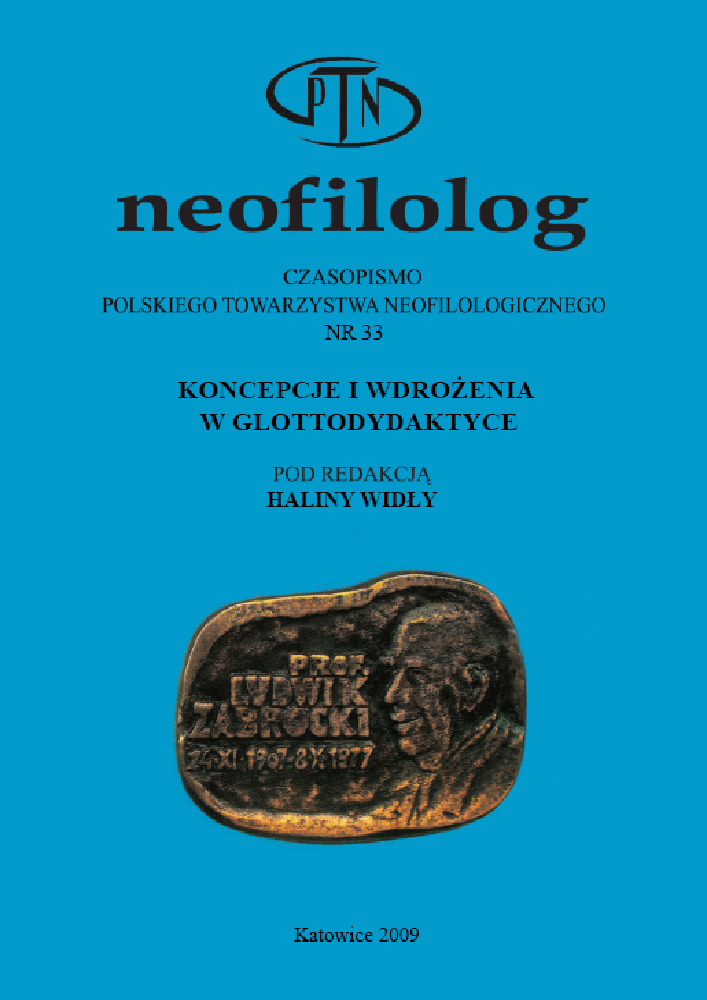Abstrakt
The author of this paper explores the issue of the comprehension of phraseological units. The problem is of great importance not only to linguistics but also to the theory of language learning-teaching as comprehension and phraseological unit acquisition are important factors in the process of teaching any language. The complex semantic structure of phraseological units has resulted in a number of hypotheses which describe the ways in which phraseological units are interpreted. The paper is a review of these hypotheses from a current perspective.
Bibliografia
Bobrow S. A. i Bell S. M. 1973. “On catching on to idiomatic expressions”. Memory and Cognition, 1, no3 : 343 – 346.
Brassard C., Somesfalean S. i Toussaint A. “Le décodage des expressions idiomatiques”, www.er.uqam.ca/nobel/scilang/cesla98/textes/5TXTCARO.html, DW 20.02.2009 :1 – 15.
Cacciari C. i Tabossi P. 1988. “The comprehension of idioms”. Journal of Memory and Language, 27: 668 – 683.
Chomsky N. 1980. Rules and representations. New York: Columbia University Press.
Cieślicka A. 2006. „W poszukiwaniu pomostu między psycholingwistyką a dydaktyką. Implikacje badań psycholingwistycznych nad kompozycyjnością idiomów dla rozwoju obcojęzycznej kompetencji metaforycznej”, (w) Komunikacja językowa w społeczeństwie informacyjnym - nowe wyzwania dla dydaktyki języków obcych, (red. J.Knieja, U.Paprocka-Piotrowska), Lublin: Tow. Naukowe KUL :156 – 172.
Estill R.i Kemper S.1982. “Interpreting idioms”. Journal of Psycholinguistic Research 11, no 6: 559 – 568.
Fraser B. 1970. “Idioms within a transformational grammar”. Foundations of Language, no 6 (1) : 22 – 42.
Gibbs R. W. 1980. “Spilling the beans on understanding and memory for idioms in conversation”. Memory and Cognition, 8: 149 – 156.
Gibbs R. W. 1986 “Skating on thin ice: literal meaning and understanding idioms in conversation”. Discourse Processes, 9: 17 – 30.
Gibbs R. W. i Nayak N.P. 1989. “Psycholinguistic studies on the syntactic behavior of idioms”. Cognitive Psychology, no 21: 100 – 138.
Gibbs R. W., Nayak N.P. i Cutting C. 1989. “How to kick the bucket and not decompose: Analizability and idiom processing”. Journal of Memory and Language, no 28: 576 – 593.
Gleason J. B. i Ratner N. 2005. Psycholingwistyka, Gdańsk: Gdańskie Wydawnictwo Psychologiczne.
Gross G. 1996. Les expressions figées en français – noms composés et autres locutions, Paris: Collection l’Essentiel Français, Éditions Ophrys.
Iralde L. i Lainé A. 2004. “Compréhension d’expressions idiomatiques familières selon leur degré de transparence métaphorique chez l’enfant et l’adolescent de langue maternelle française”. Le Langage et L’Homme, vol. XXXIX, no 2 (décembre 2004) : 141 – 166.
Katz J.J. 1973. “Compositionality, idiomaticity and lexical substitution”. A festshrift for Morris Halle (red. S.R.Anderson, P.Kiparsky). New York: Holt, Reinhart and Winston: 357 – 376.
Lewicki A.M. 2003. Studia z zakresu frazeologii, Łask: Oficyna Wydawnicza Leksem.
McGlone M.S., Glucksberg S. i Cacciari C. 1994. “Semantic productivity and idiom comprehension”. Discourse Processes, 17: 167 – 190.
Onifer W. i Swinney D. 1981. “Accessing lexical ambiguities during sentence comprehension: Effects of frequency meaning and contextual bias”. Memory and Cognition, 9, no 3 : 225 – 236.
Permiakov G. 1988. Tel grain, tel pain – Poétique de la sagesse populaire. Moscou: Éditions du Progrès.
Searle J.P. 1979. “Metaphor”, (w) Metaphor and thought (red. A.Ortony). Cambridge University Press.
Swinney D.A. 1979. “Lexical access during sentence comprehension: (re)consideration of context effects”. Journal of Verbal Learning and Verbal Behavior, 18: 645 – 660.
Swinney D.A. i Cutler A. 1979 “The access and processing of idiomatic expressions”. Journal of Verbal Learning and Verbal Behavior, 18: 523 – 534.
Titone D.A. i Connine C.M. 1994a. “The comprehension of idiomatic expressions : Effects of predictability and literality”. Journal of Experimental Psychology : Learning, Memory and Cognition 20, no 5 : 1126 – 1138.
Titone D.A. i Connine C.M. 1994b. “Taking on semantic commitments: Processing semantically non-decomposable and decomposable idioms”, (w) 7th Annual CUNY Conference on Human Sentence Processing.
Titone D.A. i Connine C.M. 1999 “On the compositional and non compositional nature of idiomatic expressions”. Journal of Pragmatics, 31: 1655 – 1674.
Weinreich U. 1969. “Problems in the analysis of idioms”. Substance and structure of language (red. J.Puhvel). Los Angeles: University of California Press: 23 – 81.
Licencja
Prawa autorskie (c) 1970 Monika Sułkowska

Utwór dostępny jest na licencji Creative Commons Uznanie autorstwa – Bez utworów zależnych 4.0 Międzynarodowe.
Przedstawiany utwór (artykuł) upubliczniany jest na podstawie umowy z autorem i na licencji Creative Commons Attribution-NoDerivatives 4.0 International (CC BY-ND 4.0).
Użytkownicy mają obowiązek podania wraz z rozpowszechnionym utworem, informacji o autorstwie, tytule, źródle (odnośniki do oryginalnego utworu, DOI) oraz samej licencji;
- bez tworzenia utworów zależnych,
- utwór musi być zachowany w oryginalnej postaci.
Uniwersytet im. Adama Mickiewicza w Poznaniu zachowuje prawo do czasopisma jako całości (układ, forma graficzna, tytuł, projekt okładki, logo itp.).
